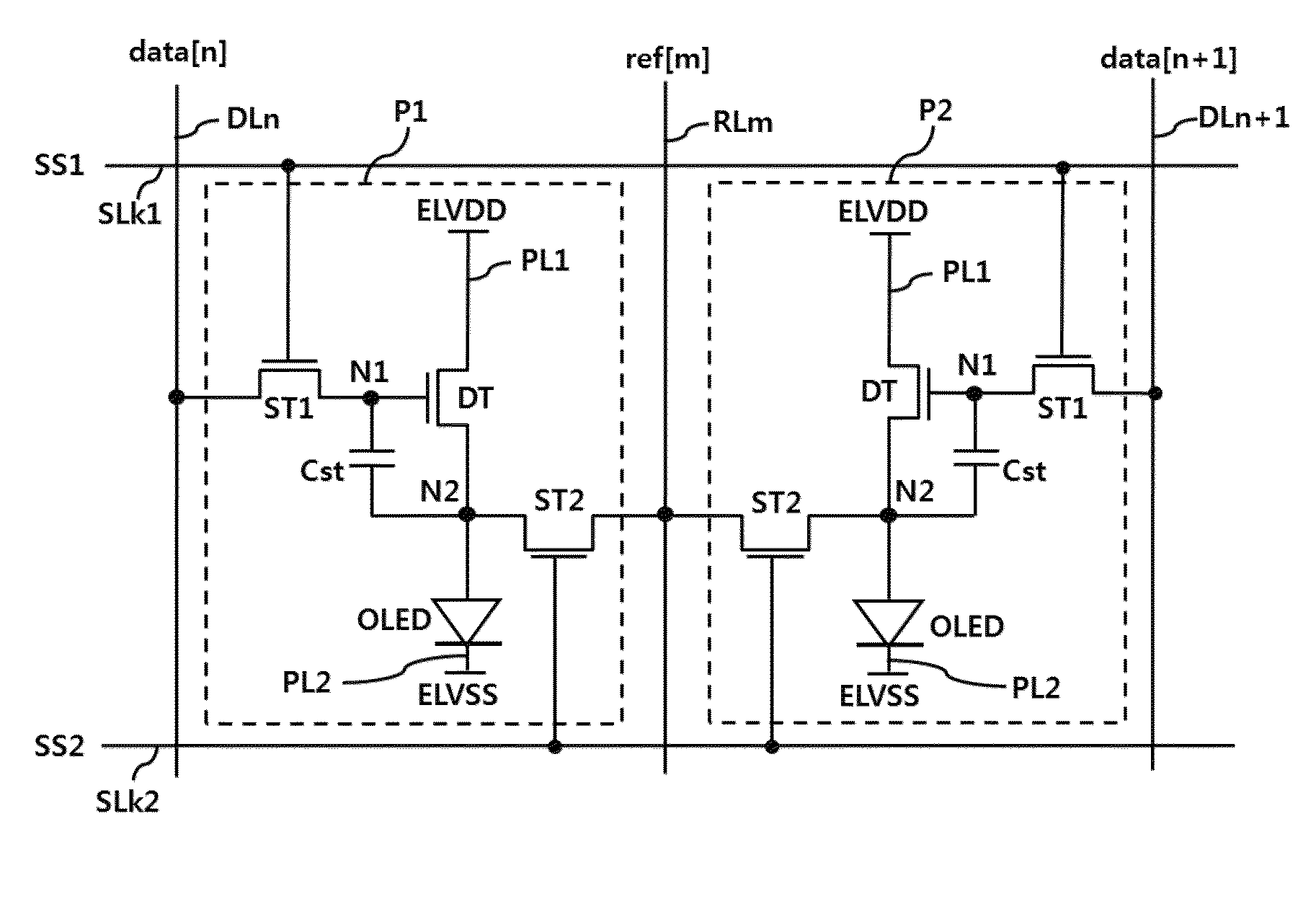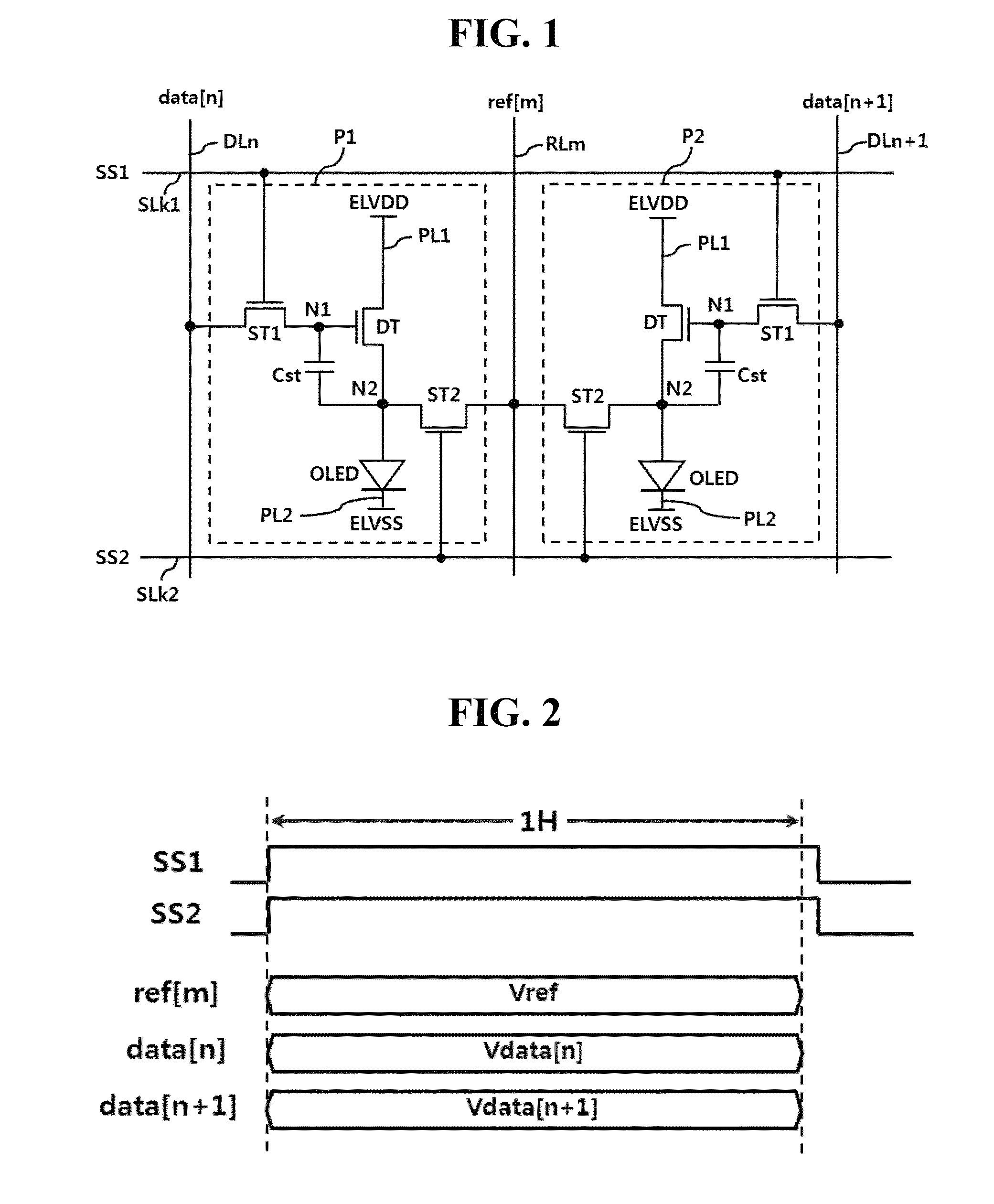Organic light emitting diode display device for sensing pixel current and pixel current sensing method thereof
a light-emitting diode display device and pixel current technology, applied in the field of organic light-emitting diode display devices, can solve the problems of generating residual images, reducing the lifespan of amoled display panels, generating deviations in driving tfts of pixels, etc., to reduce the number of reference lines, increase the pixel aperture ratio, and reduce the number of reference channels
- Summary
- Abstract
- Description
- Claims
- Application Information
AI Technical Summary
Benefits of technology
Problems solved by technology
Method used
Image
Examples
first embodiment
[0048]FIG. 1 is an equivalent circuit diagram of two typical pixels of an OLED display device for sensing pixel current according to the present invention.
[0049]The OLED display device shown in FIG. 1 includes first and second pixels P1 and P2 respectively connected to two neighboring data lines DLn and DLn+1 (n being a natural number), a reference line RLm (m being a natural number) shared by the first and second pixels P1 and P2 between the data lines DLn and DLn+1, and first and second scan lines SLk1 and SLk2 (k being a natural number) that intersect the data lines DLn and DLn+1 and the reference line RLm and are shared by the first and second pixels P1 and P2.
[0050]The first and second pixels P1 and P2 arranged in the horizontal direction respectively represent first and second pixel strings that share the reference line RLm. The first and second pixels P1 and P2 are respectively connected to the two data lines DLn and DLn+1 extended in the vertical direction. The reference lin...
second embodiment
[0089]FIG. 5 is an equivalent circuit diagram of four typical pixels of an OLED display device for sensing pixel current according to the present invention.
[0090]The second embodiment shown in FIG. 5 has the same concept as the first embodiment shown in FIG. 1 and is distinguished from the first embodiment in that each reference line RLm is branched to at least two lines such that four neighboring pixels P1 to P4 in the horizontal direction share one reference line RLm. Accordingly, explanation of components equal to the corresponding components shown in FIG. 1 is omitted or simplified.
[0091]In FIG. 5, first to fourth pixels P1 to P4 arranged in the horizontal direction respectively represent pixel strings. The first to fourth pixels P1 to P4 are respectively connected to four data lines DLn to DLn+3 extended in the vertical direction and commonly connected to first and second scan lines SLk1 and SLk2 extended in the horizontal direction. The reference line RLm is branched to a firs...
third embodiment
[0115]FIG. 9 is an equivalent circuit diagram of two typical pixels of an OLED display device for sensing pixel current according to the present invention.
[0116]The third embodiment shown in FIG. 9 has the same concept as the first embodiment shown in FIG. 1 and is distinguished from the first embodiment in that the second switching TFTs ST2 of the first and second pixels P1 and P2 are respectively connected to the second and third scan lines SLk2 and SLk3. Accordingly, explanation of components equal to the corresponding components shown in FIG. 1 is omitted or simplified.
[0117]Referring to FIG. 9, the first switching TFTs ST1 of the first and second pixels P1 and P2 are commonly connected to the first scan line SLk1, the second switching TFT ST2 of the first pixel P1 is connected to the second scan line SLk2, and the second switching TFT ST2 of the second pixel P2 is connected to the third scan line SLk2. Accordingly, the second switching TFT ST2 of the first pixel P1 can be drive...
PUM
 Login to View More
Login to View More Abstract
Description
Claims
Application Information
 Login to View More
Login to View More - R&D
- Intellectual Property
- Life Sciences
- Materials
- Tech Scout
- Unparalleled Data Quality
- Higher Quality Content
- 60% Fewer Hallucinations
Browse by: Latest US Patents, China's latest patents, Technical Efficacy Thesaurus, Application Domain, Technology Topic, Popular Technical Reports.
© 2025 PatSnap. All rights reserved.Legal|Privacy policy|Modern Slavery Act Transparency Statement|Sitemap|About US| Contact US: help@patsnap.com



